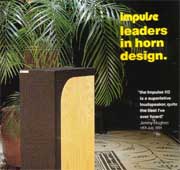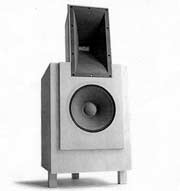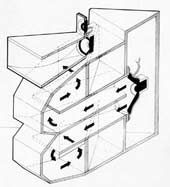
|
Impulse HT1: The original monster Impulse speaker. A complex bifurcated, folded 'corner horn' Folded exponential bass horn, tractrix midhorn with driver open to rear and separate tweeter on sub-baffle. Sensitivity not given, but 10W given as an 'adequate for domestic use'.
Drivers: 10" Peerless bass; 4" Isophon mid; 1" Coles dome tweeter.
Multi-element series crossover (crossover points not given); 8ohm impedance
Size: 36" H x 17" W x 19" D (900mm x 425mm x 500mm approx.)
Finishes: Black grile, hessian, choice of 12 cloth inserts.
Power handling 30W max.(!)
Available 1982 - ?
References: Brochure; Cover of HifI Answers March 1982 (JPEG format, 140K per page)
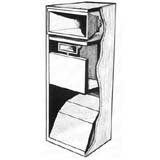
|
Impulse H2a: The follow-up to the HT1. Folded bass horn, tractrix midhorn and tweeter loading. Sensitivity 96dB/W, 8ohms.
A variant, the H2b, was available with higher power handling for studio and other professional use
Drivers: not given; bandwidth 30Hz - 20Khz +/-5dB (dependant on location in room)
Size: 45" H x 17" W x 20" D (1150mm x 425mm x 500mm approx.)
Finishes: Mahogany, or others to order.
Price: £1400; available 1982 - ?
References: Advertisement; Brochure; Brief review in HifI Answers September 1982 (JPEG format, 150K per page)
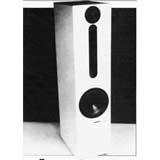
|
Impulse H3: A follow-up to the H2a, and a slight oddball. 3-way based on Seas drivers, with a sealed bass alignment, horn-loaded midrange arranged with mouth vertical, and tweeter at the top of a tall cabinet. Approx 91dB/W, 8ohms.
Drivers: 8" Seas bass; 4.5" Seas mid; Seas plastic dome tweeter
Crossover ponts: 400Hz; 4Khz
Size: 1080mm H x 255mm W x 380mm D
Weight: approx 36KG / 80lb each.
Finishes: Teak, Walnut, Black Ash or Colourcore laminate (2 pairs made, 1 yellow, 1 blue)
Available: 1985 - ?; List price £950 - 1150 depending on finish.
Reviews:Jimmy Hughes in HiFi Answers, September 1985.
Page 1 Page 2 (GIF format, 260K per page)
Update (Jul 09): The Banana Splits, Impulse's own yellow review pair, still live! Andrew Hockley kindly forwarded some pictures of these, with the drivers now restored and sounding very good.
H3 Front; H3 back; H3 crossover . Thanks, Andrew.
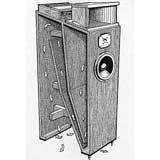
|
Impulse H1: The big hit, and an evolution from the HT1, H2a and H3 models to the archectypal 'Impulse' truncated horn design. Folded exponential bass horn, tractrix midhorn with driver open to rear. Sensitivity 94dB/W, 8ohms.
Drivers: 8.5" Seas bass; 4.5" Seas mid; Focal TD90K tweeter.
Crossover ponts: 800Hz; 4Khz; 2nd order summed response.
Size: 1100mm H x 350mm W x 685mm D
Finishes/ cost: Approx. £2,800: built to order, customer-specified veneer with cloth inserts.
Weight: if you have to ask...
Available 1988 - ?
Reviews:Jimmy Hughes in HiFi Answers, February 1989. It's a bit of an odd review, for a rave write-up...
Page 1 Page 2 Page 3 Page 4 (GIF format, 120-220K per page)
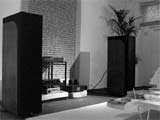
|
Impulse H2: Arguably the best of the lot. A derivative of the H1 which appears to have superceded it. Mostly handmade cabinet, same driver complement as H1, but a simplified bass horn folding leads to reduced cabinet volume with negligible loss of sensitivity and extension. Capable of stupendous bass quality and extension - although specified for cutoff at 40Hz, in-room measurements at home show extension flat down to 30Hz, -6dB at c.27Hz. Positioning close to the rear wall is recommended, but this speaker is remarkably unfussy about siting. Tractrix midhorn with driver open to rear and top, inverted-dome tweeter Sensitivity 95dB/W, 8ohm
Drivers: 8.5" Seas bass; 4.5" Seas mid; Focal tweeter.
Crossover ponts: 800Hz; 4Khz; 2nd order summed response.
Size: 1160mm H x 270mm W x 480mm D
Finishes: Rosewood or Oak with cloth inserts
Weight: approx 65KG / 140lb each.
Available: 1991-1996(?); list price c.£2,300
Reviews: 3 raves to pick from! (note these are all large images - 1024 pixels wide, GIF format, c. 250Kb)
Jimmy Hughes in the Audiophile, June 1991:Page 1 Page 2 (B&W photo)
What Hifi?, April 1992: Page 1 Page 2
What Hifi?, Summary: May 1992: May 92
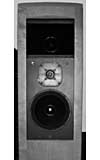
|
Impulse Ta'us: Effectively the H2 mk.2, this model had a curved front baffle which oversails the rest of the cabinet, making it slightly wider and taller than its predecessor although retaining the same driver complement. The rear of the mid-horn is enclosed in a sealed chanber stuffed with absorbant, a change from the H2. 94dB/W, 8ohm
Drivers: 8.5" Seas bass; 4.5" Seas mid; Focal TD90K tweeter.
Crossover ponts: 800Hz; 4.5Khz; 2nd order summed response.
Size: 1210mm H x 300mm W x 480mm D
Finishes: Painted cabinet with maple / Beech front baffle
Weight: approx 65KG / 140lb each.
Available: 1995-97; list price c.£3,000
Reviews: Cyberfi magazine, 1995 ; also see VMX.com online at http://www.vxm.com/21R.88.html
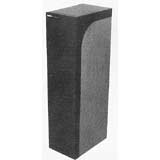
|
Impulse H4: The replacement for the H3, re-styled to match the H1. 3-way based Seas and Focal drivers; bass loading unknown, but retained horn-loaded midrange with new Focal tweeter. Sensitivity unknown.
Available: 1987-?; Built to order, £1100
Reviews:Jimmy Hughes in HiFi Answers, June 1987
H4 review (GIF format, 184K)
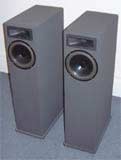
|
Impulse H5: A 2-way based on lessons learned from the H1. 8.5" bass driver essentially shares its horn enclosure with the H2 design. 1" dome tweeter, horn-loaded.
Drivers: 8.5" Seas bass; Searola tweeter.
Crossover: -
Size: 970mm H x 266mm W x 470mm D
Weight: -
Finish: Nextel
Available: Not sure - but rare!
Reviews: none available.
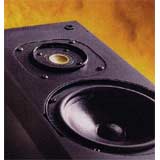
|
Impulse H6: A compact two-way floorstander, and probably the most popular in the range - for good reasons! Punch well above their weight, and sound best a little way off the back wall.
Drivers: 6.5" Seas bass; Focal TD90K tweeter.
Crossover ponts: 4.5Khz, first order
Size: 930mm H x 180mm W x 350mm D
Weight: approx 25KG / 60lb each.
Finishes: Painted; veneers available to special order
Available: 1992-?; list price £1250
Reviews: Malcolm Steward and Jimmy Hughes in Audiophle, July 1992.
Page 1
Page 2
Page 3
Page 4
Picture: H6 and H7 models, B&W advertisement , from Audiophile April 1994.
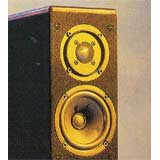
|
Impulse H7: The very smallest horn incarnation! Tiny drivers in tiny-for-a-ho�° cabinet, and some problems in crossover range means this is the least succesful of the Impulse designs. Small driver size leads to inevitably low sensitivity: 86dB/W, nominally 8ohms, but actually rather hard to drive - impedance dips to just 2ohms through midrange.
Drivers: 3.5" bass; 1" metal dome tweeter.
Crossover: ?
Size: tiny!
Weight: ?
Available: 1994-? list price £785
Reviews: Paul Messenger in HiFi Choice, July 1994: H7 review
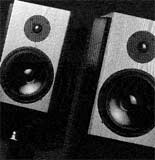
|
Impulse Maya: A departure for Impulse, a 2-way sealed-box standmount. Following a change of leadership at Impulse, the company looked to diversify its speaker lineup. The Maya was the first, and possibly last, move in this direction. Approx 89dB/W, 8ohms,
Drivers: Seas doped-paper bass/midrange; Seas metal-dome tweeter.
Crossover: 'first order'
Size: Standmount
Weight: ?
Finishes: Black ash with blond ash, cherry or rose front and top panels
Available: 1998: 'under £700'
Reviews: Jimmy Hughes, February 1998: Page 1 Page 2 Page 3

|
Impulse Kora; Impulse Lali
As the Ta'us is to the H2, the Kora and Lali are Mark 2 versions of the H7 and H6 respectively. Again, these models have a curved front baffle which oversails the rest of the cabinet, making them slightly wider and taller than its predecessor. Driver compliment and other information similar to H7 & H6, but updated crossovers and cabinet finishes.
Kora: No reviews available - can you help?.
Lali: Reviews: Chris Beeching in HifiNews & Record Review, October 1995.
Page 1 Page 2
| | | | | | | | | | | |
